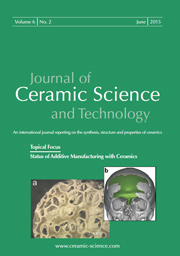Articles
All articles | Recent articles
The Compositions and Pore Structures of Benshanzhu Zisha Ceramics
Yu Lin1, Chunyan Hu1, Defang Ding1, Haidong Hang1, Chunrui Yang2, Yuanbing Li2, Yi Shen1
1 Engineering Research Center of Nano-Geomaterials of Ministry of Education, Faculty of Materials Science and Chemistry, China University of Geosciences (CUG), 388 Lumo Road, Wuhan 430074, P. R. China
2 Key Laboratory of Metallurgical Equipment and Control Technology, Wuhan University of Science and Technology, Wuhan, 430081, China
received March 2, 2021, received in revised form April 15, 2021, accepted May 3, 2021
Vol. 12, No. 2, Pages 107-114 DOI: 10.4416/JCST2021-00004
Abstract
Yixing Zisha ceramics are popular traditional tea-sets with a long history in China but there have seldom been studies exploring their compositions and microstructures. In this work, Benshanzhu-Zisha, a typical representative of Zisha clay from the city of Yixing in China, is investigated. The XRD results demonstrate that the Benshan Zhu clay is a natural mineral compound with a high content of hematite. After sintering, in comparison with pottery and porcelain, Benshanzhu-Zisha has the highest hematite (11.5 wt%) and amorphous phase (71.2 wt%) and the lowest mullite phase (10.7 wt%). Moreover, there are many dispersed and thin pores contained in the Benshanzhu-Zisha, ranging from nanometers to microns in size, and there are large numbers of hematite particles in the pores. It is the unique pore structures that make Benshanzhu-Zisha the perfect vessel for brewing tea, impermeable to water but gas "breathable".
![]() Download Full Article (PDF)
Download Full Article (PDF)
Keywords
Zisha, traditional ceramics, Yixing, pore structures
References
1 Fang, J.J., Fei, Y.Y.: A brief introduction to the aesthetic features of zisha pottery, Jiangsu Ceramics, 12, 39 – 41, (2006).
2 Lee, V., Attinger, D.: Thermodynamics and historical relevance of a jetting thermometer made of chinese zisha ceramic, Sci. Rep., 6, 28609 (2016).
3 Zhu, J., MacDonald, B.L., Hang, T., Zhu, Z.W.: Glascock MD. compositional characterization of zisha clay from the yixing area (Jiangsu, China) by neutron activation analysis, Microchem. J., 147, 1117 – 1122 (2019).
4 Wu, J., Hou, T., Zhang, M.L., Li, Q.J., Wu, J.M., Li, J.Z., Deng, Z.Q.: An analysis of the chemical composition, performance and structure of china yixing zisha pottery from 1573 A.D. to 1911 A.D., Ceram. Int., 39, 2589 – 2595, (2013).
5 Chung, T.Y., Kuo, P.C., Liao, Z.H., Shih. Y.E., Yang, M,L,, Cheng, M.L., Wu, C.C., Tzen, J.T.C.: Analysis of lipophilic compounds of tea coated on the surface of clay teapots, J. Food Drug Anal., 23, 71 – 81, (2015).
6 Liao, Z.H., Chen, Y.J., Tzen, J.T., Kuo, P.C., Lee, M.R., Mai, F.D., Rairate, T., Chou, C.C.: Effect of teapot materials on the chemical compositions of oolong tea infusion, J. Sci. Food Agric., 98, 751 – 757, (2018).
7 Yang, C.R., Kong, J.Y., Yang, J.J., Chu, C.L., Wang, X.D., Li, Y.B.: The study of crystal-phase composition and pore structure for dicaoqing-zisha compared with porcelain and pottery, Ceram. Int., (2020).
8 Zhu, Z.W., Shen, Y.Q.: Yixing Zisha mineral. Geological Publishing House; Beijing, 2009, in Chinese.
9 Mcconville, C.J., Lee, W.E.: Microstructural development on firing Illite and Smectite clays compared with that in Kaolinite. J. Am. Ceram. Soc., 8, 2267 – 2276, (2010).
10 Lee, W.E., Souza, G.P., Mcconville, C.J.: Taevornpanich T, Iqabal Y. Mullite formation in clays and clay-derived vitreous ceramics. J. Eur. Ceram. Soc., 28, 465 – 471, (2008).
11 Lao, X.B., Xu, X.Y., Jiang, W.H., Liang, J., Miao, L.F., Wu, Q.: Influences of impurities and mineralogical structure of different kaolin minerals on thermal properties of cordierite ceramics for high-temperature thermal storage. Appl. Clay Sci., 187, 105485, (2020).
12 Abd Aziz, M.H., Othman, M.H.D., Hashim, N.A., Adam, M.R., Mustafa, A.: Fabrication and characterization of mullite ceramic hollow fiber membrane from natural occurring ball clay, Appl. Clay Sci., 177, 51 – 62, (2019).
13 Chin, C.L., Ahmad, Z.A., Sow, S.S.: Relationship between the thermal behaviour of the clays and their mineralogical and chemical composition: Example of Ipoh, Kuala Rompin and Mersing (Malaysia). Appl. Clay Sci., 143, 327 – 335, (2017).
14 Kamseu, E., Leonelli, C., Boccaccini, D.N., Veronesi, P., Miselli, P., Pellacani, G., Melo, U.C.: Characterisation of porcelain compositions using two china clays from Cameroon. Ceram. Int., 33, 851 – 857, (2007).
15 Gualtieri, A.F.: Thermal behavior of the raw materials forming porcelain stoneware mixtures by combined optical and in situ X-Ray dilatometry. J. Am. Ceram. Soc., 90, 1222 – 1231, (2007).
16 Dong, W.X., Bao, Q.F., Zhou, J.E., Zhao, T.G., Liu, K., Li, S.Z., Liu, S.Y., Ma, K.X.: Comparison and low-temperature sintering mechanism of "K2O-Na2O" and "Li2O-K2O-Na2O" fluxes, J. Ceram. Soc. Jpn., 128, 821 – 831, (2020).
17 Bahgat, M., Abdel Halim, K.S., El-Kelesh, H.A., Nasr, M.I.: Metallic iron whisker formation and growth during iron oxide reduction: K2O effect, Ironmak. Steelmak., 36, 379, (2009).
Copyright
Göller Verlag GmbH


